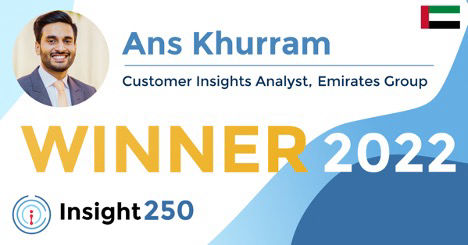Storytelling through insights
The challenges and benefits of data-driven storytelling in today’s business world

The Insight250 spotlights and celebrates 250 of the world’s premier leaders and innovators in market research, consumer insights, and data-driven marketing. The inaugural list was revealed in April 2021 (and the latest 2022 winners were announced at ESOMAR Congress in Toronto last September), creating renewed excitement across the industry whilst strengthening the connectivity of the market research community.
With so many exceptional professionals named to the Insight250, it seems fitting to tap into their expertise and unique perspectives across various topics. This weekly series does just that; inquiring about the expert perspectives of many of these individuals in a series of short topical features.
To use an analogy, obtaining robust and reliable insights merely builds the foundations of a house – to complete the house, those insights need to be effectively communicated to ensure they are understood and then actioned. The great news is that insights are becoming more robust and informative and brands are increasingly using them to drive decisions and craft stories. I sat down with Ans Khurram, a leading customer insights analyst in the aviation industry, to tap into his expertise and get his perspectives on the challenges and benefits of data-driven storytelling in today’s business world. This fascinating discussion covers an array of topics from one of the emerging leaders in our space.
Great to talk to you, Ans. Many people talk about “storytelling,” but you use the phrase “data storytelling.” How do they differ?
“I think market research and analysts, in general, focus too much on the ‘what’ of a business question instead of the ‘why.’ Data storytelling essentially goes the extra mile to explain why something might be happening. This process is dynamic and keeps evolving - it does not happen overnight. Mostly you start with converting ‘hunches’ into actual behaviours by providing data, and over time you help the business overcome data blind spots with perspectives they never had.”
Ans Khurram
How do compelling narratives make insights more actionable?
“They help stakeholders understand where they can intervene or potential actions they can take. Determining scientific ‘‘causation”, especially for consumer behaviours is close to impossible for businesses as things move very fast (they usually needed the insight yesterday) and human actions are influenced by multiple factors. I like to say that while correlation isn’t causation, multiple correlations aren’t a coincidence either. My narratives are essentially the hypothesis I explored to help explain market trends/behaviours. I try to provide the stakeholders with a starting point to discuss the data and refine the analysis by working with them to incorporate their interpretations as well.”
Ans Khurram
What makes a great data story?
“In my opinion, a great data story usually has three things. First, as mentioned above, it attempts to explain trends/behaviours by answering the hypothesis. Second, this method will invariably lead you to explore multiple data sources - this can encompass different first-party platforms, market research, and even third-party reports. Third, the story will use qualitative data points to make the numbers more relatable. To quote Ken Burns, ‘Particularize so that we are not anaesthetized by the sheer volume of the numbers.’ I really think the power of qualitative data is under-utilized to make a point.”
Ans Khurram
Is the old adage “less is more” relevant here?
“I feel the adage should be ‘to show less, you need to work more.’ A good data story picks the most relevant numbers to answer the hypothesis. To choose these relevant numbers, you must analyse the data set from many, many…many angles! Often times you exclude the most interesting number as it does not fit into the overall narrative. Not only that, you also prepare for cross-questions and call out significant variations across demographics or segments of interest. Most importantly, you must draw a line to avoid going down the ‘analysis-paralysis’ hole- any data story keeps evolving.”
Ans Khurram
To deliver great insights, is focusing on the techniques or the output most important?
“Both. You have to contextualise the numbers in the most accurate way possible so that the interpretation is not misleading and does not cast doubt on the technique. Similarly, you try and ensure that the key takeaway becomes obvious at first glance of any output. In order to make this happen, you try to present the numbers as per business language and also generalise an analysis or a slide in a sentence or two. The biggest challenge is reconciling conflicting data sources. More often than not, in my experience, it’s a matter of comparing apples with oranges; the moment that it’s an apple-to-apple comparison, everything clicks.”
Ans Khurram
How is technology helping to improve data storytelling?
“I am not sure if technology has necessarily improved data storytelling, but I think it has definitely made data storytelling more important. Thanks to technology, we can now measure many things, access vast amounts of data, and even process it more quickly. But we still need to distil all this information into something meaningful.”
Ans Khurram
Can AI help in data storytelling and will it eventually replace the need for human data storytellers?
“Maybe? This is really an open-ended question (no pun intended). In due time, AI might be able to point you in all the relevant directions when it comes to processing quantitative data. But I am curious to see how it will deal with more qualitative things like ideations, observations, business experience, etc. I do not think AI can contextualise things like humans do, at least for a while.”
Ans Khurram
HOT TOPICS: Client: Agency Partnerships
You’ve worked in leading agencies and global enterprise brands - how do the roles differ, and how can agencies and clients better work together?
“I’d say there is sometimes a lack of empathy from both sides. For agencies, your clients generally know what is happening and help them understand why. Try and add value by understanding your client’s industry and leveraging 3rd party data platforms - plenty of free ones are out there. Clients need to embolden their agencies and treat them as partners; be open to experimenting (with that comes making mistakes) and trying new things. Most importantly, always keep them updated about the burning business issues so they can work towards addressing them.”
Ans Khurram
TOP TIP
“Leverage Goodhart’s Law for insights: “When a measure becomes a target, it ceases to be a good measure”
Ans Khurram
A common theme that we hear from Insight250 Winners in this series is that technology often is too much of the focal point of innovation, to the detriment of people. Ans echoes this sentiment, saying, “Thanks to technology, we can now measure many things, access vast amounts of data, and even process it more quickly. But we still need to distil all this information into something meaningful.” In other words, technology gets us part of the way there, but it's the human expertise that is vital to developing the story.
 As a Customer Insights Analyst for Emirates Group, Ans Khurram identifies market trends and customer behaviours and leverages first-party data to build data-informed strategies around the acquisition and retention of customers. He focuses on deriving actionable insights by weaving data from multiple touchpoints to build a coherent narrative for brands. Aside from being an Insight250 Winner, he was also named to the 30 under 30 rising stars of business analytics by Business of Data.
As a Customer Insights Analyst for Emirates Group, Ans Khurram identifies market trends and customer behaviours and leverages first-party data to build data-informed strategies around the acquisition and retention of customers. He focuses on deriving actionable insights by weaving data from multiple touchpoints to build a coherent narrative for brands. Aside from being an Insight250 Winner, he was also named to the 30 under 30 rising stars of business analytics by Business of Data.
Crispin Beale
Chairman at QuMind, CEO at Insight250, Senior Strategic Advisor at mTab, CEO at IDXCrispin Beale is a marketing, data and customer experience expert. Crispin spent over a decade on the Executive Management Board of Chime Communications as Group CEO of leading brands such as Opinion Leader, Brand Democracy, Facts International and Watermelon. Prior to this Crispin held senior marketing and insight roles at BT, Royal Mail Group and Dixons. Crispin originally qualified as a chartered accountant and moved into management consultancy with Coopers & Lybrand (PwC). Crispin has been a Board Director (and Chairman) of the MRS for nearly 20 years and UK ESOMAR Representative for c15 years. As well as being CEO of Insight250, Crispin is currently Worldwide CEO of Digital Communications Solution Agency, IDX. Crispin is also the Senior Strategic Advisor at mTab and the Chairman of QuMind and spent 4 years as Group President of Behaviorally where he was responsibile for the client & commercial teams globally. Crispin is a passionate advocate for blending human intelligence and technology to deliver innovation and leadership across organisations.

